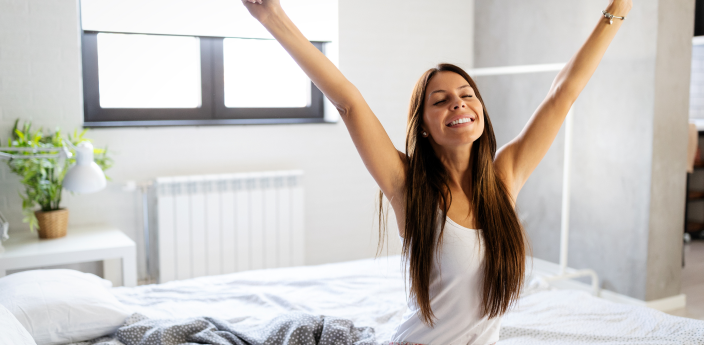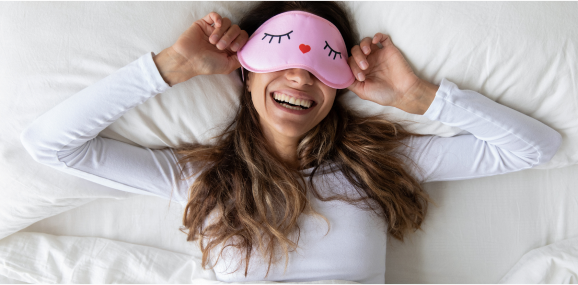Have you ever watched a child sleep? Children who don’t have sleep issues tend to switch their positions multiple times during the night, waking up well-rested and without the classic lower back pain that most adults have become accustomed to.
It may be tempting, then, to look at children and wonder what their sleep secret is. As adults, we invest massive amounts of time and money to achieve better sleep quality so we can get the rest we so desperately need.
The Hug Sleep crew understands. We ourselves went to great lengths to find a better way to rest — including researching which sleeping position is the best.
Here, we’ll discuss all things sleeping positions, including whether or not side sleepers should pick a side (pun intended).
Does Sleep Position Really Matter?
The body does most of its reparative and restorative work while you’re asleep, with sleep impacting your immunity, your mental health, and your overall mood.
So as long as you’re asleep, sleep position shouldn’t matter, right?
Wrong.
Studies suggest that the position you sleep in does affect the health benefits you receive from slumber.
Because we spend approximately one-third of our lives asleep, it turns out that the position we sleep in is really important. Sleeping in a position that doesn’t support the body and align the spine can cause us to wake with low back pain, neck pain, shoulder pain, and a general sense of sleeplessness.
A Problem Worth Solving
All sleep is good sleep… until it causes us to wake up feeling sore or exacerbates health conditions like pregnancy, GERD, and heart issues. Turns out, our favorite sleeping position might not be the best way for us to sleep.
According to experts, the best sleep position is one that supports the neck and helps ensure proper spinal alignment. That position could be different for everyone.
An Overview of Common Sleep Positions
There are really only four sleeping positions: left side sleeping, right side sleeping, back sleeping, and stomach sleeping. Unless you’re into some serious acrobatics, you’ll usually find yourself in one of these positions upon going to bed and waking in the morning.
Each position offers at least some benefits, so we’ll look at each one below. We’ll also examine why side sleeping has become the top choice for both comfort and support.
Stomach Sleeping
You could say we’re starting at the bottom because stomach sleeping doesn’t offer many impressive benefits.
If you’re a die-hard stomach sleeper, there’s little chance of changing your mind. The good news is that stomach sleeping may be best for you if you don’t have any medical conditions and you wake up feeling refreshed.
However, the bad news about stomach sleeping is that sleeping on your stomach isn’t supportive of your spine at all. Stomach sleepers may wake with low back pain that can last hours into their day.
Likewise, when sleeping on the stomach, it’s impossible for you to rest your neck in a neutral position. Your neck will either be twisted to the left side or the right.
Sorry, stomach sleepers, but the verdict is in. Although it might be comfortable for you, the risk of neck and back pain may one day make it a nonviable sleeping position.
Back Sleeping
Back sleeping once reigned supreme as the best sleep position, but newer research has made it less popular among sleep experts.
Part of back sleeping’s fall from glory is likely due to the higher occurrence of sleep disorders in this position. For instance, people with sleep apnea are usually discouraged from sleeping on their backs as it can cause more disruption during the night.
According to the National Sleep Foundation, people who snore are more likely to snore — and snore more loudly — if they choose to sleep on their backs. This is because the tongue relaxes into the back of the esophagus, creating a restriction in the airway.
Additionally, it’s hard to get full back support lying on your back. Your lower back, for instance, will likely hurt in the morning unless you have an incredibly supportive memory foam mattress.
Side Sleeping
Sleeping on the side is the preferred favorite of most adults. In fact, 60% of all adults sleep on their sides (men more so than women).
Side sleeping offers the most benefits, including better gastrointestinal health, better brain function, and even a reduced risk of developing sleep disorders.
Below, we’ll dive into why side sleeping is so beneficial — and which side, if any, is best.
Benefits of Side Sleeping
Side sleeping is a great way to keep your spine aligned and your body in a supported position. Many people who suffer from sleep disorders are often instructed by their healthcare professionals to sleep on their sides. Here are some of the key benefits of side sleeping.
Less Snoring
Constantly getting woken up by snoring — or constantly waking up your significant other with your snores — isn’t an ideal way for anyone to get rest. Sleeping on the side keeps your tongue from relaxing too far into your esophagus, which can prevent some of your snoring and help everyone get better rest.
Better Gut Health
Heartburn, also known as acid reflux, can be painful and make sleeping very uncomfortable. If you’re a back sleeper who experiences these problems, lying on your side can help.
Gastrointestinal air also moves more easily when you’re on your side, which can help you sleep more peacefully and avoid waking up with a stomach ache.
Better Brain Function
Of all the cool features of your brain, brain glymphatic transport — which is your brain’s nighttime cleanup crew — is high on the list. The brain’s glymphatic transport system works to discard unneeded cellular material, and some researchers believe that side sleeping enhances this system’s ability to slough away the garbage.
Back Pain Relief
For the ultimate in spinal support, consider sleeping on your side. Keep your knees together and slightly bent in a relaxed fetal position — and place a firm pillow between your knees for comfort — to alleviate back pain. This is especially important for people who suffer from low back pain, because spinal alignment while sleeping often causes pain in this area.
Picking Sides
Given all its health benefits, side sleeping is a solid choice. Now, let’s figure out which side gets the best marks.
The answer isn’t as cut and dry as you might think. Instead, it will depend on your personal situation and individual health issues.
The Left Side
Sleeping on the left side is often recommended for pregnant women to get a good night’s sleep. Most doctors agree that sleeping on the back isn’t a good position for pregnancy, especially into the second trimester.
Sleeping on the left side is better for promoting blood flow between the heart and uterus, and it’s also better for the kidneys. If this position is uncomfortable, a body pillow can help.
People who struggle with GERD, or gastroesophageal reflux disease, may also benefit from sleeping on the left side. Research shows that occurrences of acid reflux and gastrointestinal discomfort are greater when sleeping on the right side as opposed to the left.
The Right Side
Sleeping on the right side is recommended for people with heart disease, heart failure, or any other heart-related problems. If you have heart issues, talk to your doctor about your sleep habits and find out which position they recommend for best sleeping.
The Bottom Line
There’s no right or wrong side on which to sleep. If your right side is most comfortable, sleep on it. Prefer the left? Roll over and catch some zzzs. Unless you have specific health conditions or have been instructed by your doctor to avoid a particular side, both sides are equally snooze-worthy.
Tips for Healthy Side Sleeping
If you have trouble sleeping on your side or just want to practice better sleep hygiene, here are three tips for becoming a side sleeping pro.
1. Invest in Your Mattress
Your mattress matters, and a firm mattress that is less than ten years old is the gold standard for good sleeping. The best mattresses still feel soft enough to be comfortable but are sturdy enough to offer spinal support.
2. Be Picky About Pillows
The best pillows are firm and supportive. If your pillow is old or causes your chin to angle downward toward your chest, it needs replacing. Supportive pillows ensure your neck is properly aligned and your airways are unrestricted.
3. Upgrade Your Blanket
If you have trouble sleeping, it may be time to upgrade your favorite blanket to one that offers DTPT, or deep pressure stimulation.
DTPT is the process of applying gentle pressure to different parts of the body to help ease stress, release tension, calm the mind, and soothe the body. Think of it like a warm hug or a favorite sweater.
DTPT and Your Sleep
Sometimes it’s just hard to sleep. Our nervous system works in overdrive, pumping out cortisol that keeps us awake at night. It’s a complex system, but there are two important parts at work: the sympathetic nervous system (SNS) and the parasympathetic nervous system (PSNS).
- SNS: The SNS keeps you alert. It’s your fight or flight response, which is the nervous system function that releases cortisol and produces feelings of worry, nervousness, and stress.
- PSNS. The PSNS relaxes your body and mind and helps prepare you for sleep. The PSNS relaxes muscles, slows your heart rate, helps you digest your food, and even works to help release serotonin and dopamine.
Sometimes, it’s hard for our bodies to transition from the SNS processes we experience during the day to the PSNS function we so desperately need at night.
Luckily, DTPT helps your body slide into PSNS, relaxing the body so you can rest. The only problem is that most of us don’t have access to a personal masseuse to gently lull us to sleep.
A solution? The Sleep Pod.
A Cocoon of Comfort, in Any Position
Using the same science that makes DTPT so effective, the Hug Sleep team developed a way to help you get the comforting deep pressure stimulation you need. The Sleep Pod is a wearable blanket that envelops you in complete comfort and gentle pressure all night long. Think of it like a swaddle, but for adults.
The unique design of the sleep pod helps it apply gentle pressure all over your body, soothing your SNS and stimulating your PSNS.
The result? A body and mind that gets ready for sleep easily, regardless of whether you prefer right side sleeping or left side sleeping.
We’re On Your Side
At Hug Sleep, we understand that getting a good night of rest is important… and sometimes challenging. Sleeping on your side can help keep you from experiencing discomfort from back pain or heartburn.
If you’re struggling to get to sleep on your side — or in any position — using the Sleep Pod or the Sleep Pod Move can help you relax so your body and mind are ready for sleep.
Sources:
What Are the Best Positions for Sleeping? | Sleep Foundation
What Are the Common Causes of Snoring? | National Sleep Foundation
Benefits and Which Side to Sleep On | Sleep Foundation
Influence of Body Posture on Intestinal Transit of Gas | PubMed
The Effect of Body Posture on Brain Glymphatic Transport | PubMed
Body Position Affects Recumbent Postprandial Reflux | PubMed
4 Ways Weighted Blankets Can Actually Help Conditions | Penn Medicine

































500,000+ happy customers